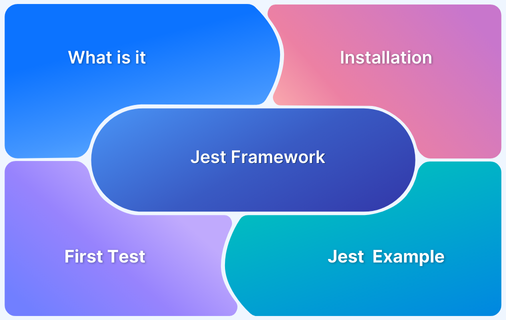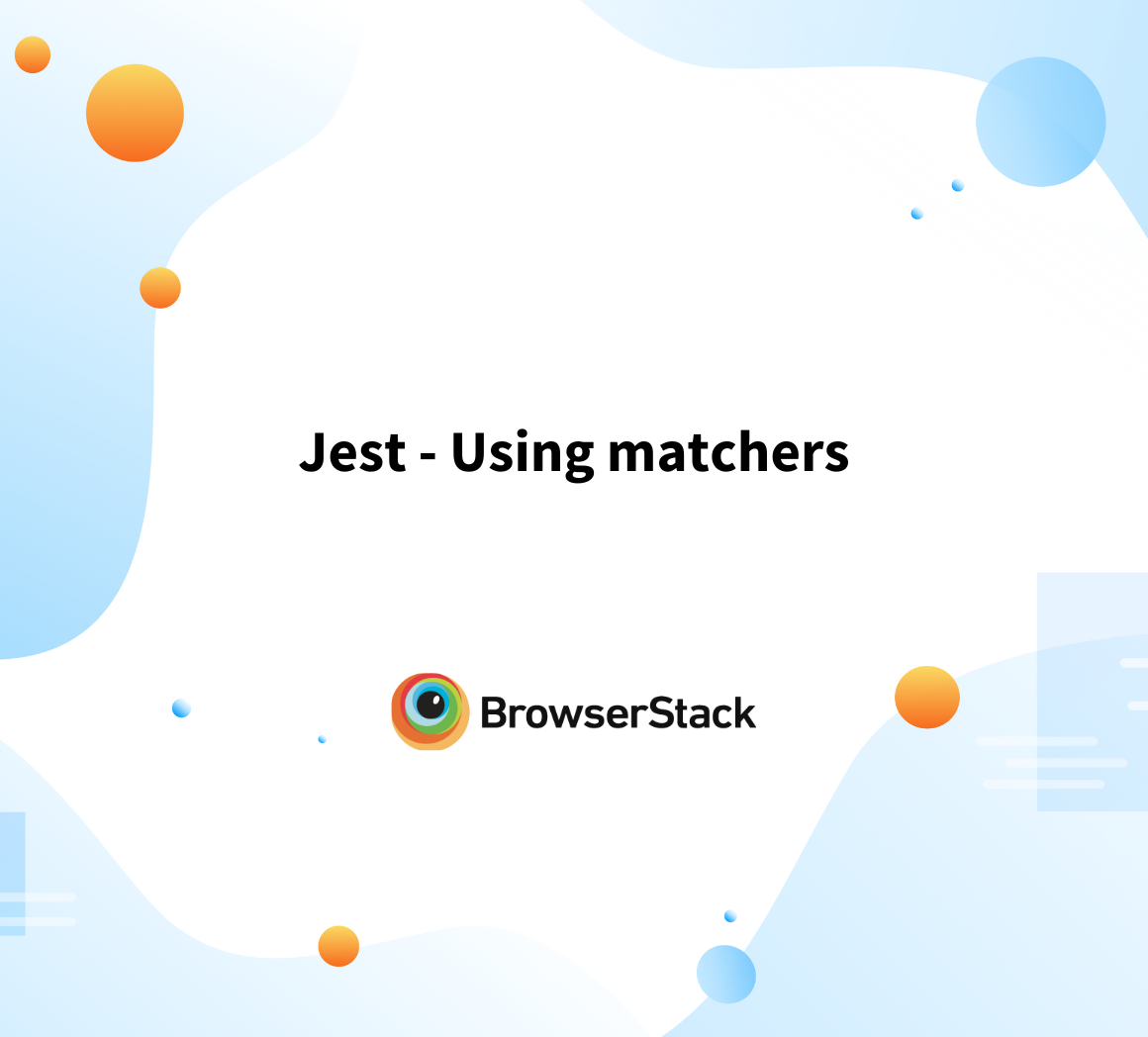Jest is a JavaScript testing framework built by the tech giant Meta in 2011. When it launched, it gained massive popularity initially because of its ability to test React components. Jest has since evolved to support Angular, Vue, Node JS, React, and more. It is important to note that Jest is a full-fledged JavaScript testing framework and not a library. This guide helps readers understand how to configure Jest.
What is the Jest Framework?
Jest is an open-source JavaScript-based testing framework that supports Angular, React, Vue, Babel, TypeScript projects, and more. The primary purpose of implementing Jest is to ease the process of testing complex web applications. It works out-of-the-box for many front-end frameworks by significantly reducing the configuration time and complexities.
Jest extends its support to test any JavaScript-based codebase. Also, it doesn’t rely heavily on third-party applications, which makes it more straightforward and more handy. It is also a faster option when executing several test scripts.
With Jest, you get an assertion library, a test runner, and a built-in mocking library, all under one roof.
Read More: Jest Framework Tutorial
What is the Jest Env File?
A Jest env file is a configuration file in the project directory that manages various settings required for running tests. It is also known as the Jest config file and is configured to customise the behaviour of your JavaScript test.
Jest env file takes several specifications such as:-
- Specifying test environments, node or jsdom.
- Defining the test files, Jest needs to consider for executing tests and what to ignore.
- Includes scripts that must be executed before running each test case, containing global variables and more.
- Customizing the test results reports and their location.
Read More: Understanding Jest DOM
Common Jest environments
You must select a Jest environment that precisely mimics the real-world conditions for which your code is intended. Different Jest environments provide a different set of APIs and behavior that determines the quality and scope of tests. Jest provides a few testing environments to fulfill different testing needs, such as:
1. Node: This is the default environment set in the Jest framework. It is suitable for back-end projects and testing code that relies upon server-side interactions. It is primarily used for testing back-end logic and all code built upon the Node.Js environment.
// jest.config.js
module.exports = {
testEnvironment: 'node',
};2. jsdom:- This Jest environment is suitable for testing client-side applications, also known as front-end applications, that rely upon browser APIs such as DOM, Windows, and more.
// jest.config.js
module.exports = {
testEnvironment: 'jsdom',
};3. Custom Environments: If none of the above options meet your testing needs, you can create custom test environments useful for specialized testing.
Jest environment variables
In Jest, environment variables are used to configure test settings, configure API, and manage other test environment parameters. The number of environment variables is not fixed; they are user-defined and vary according to your project needs.
Environment variables help to configure our Jest environment efficiently to simulate real-world conditions. In this section, discuss a few important environmental variables:-
- NODE_ENV:- Jest, by default, sets ‘node_env’ to ‘test’. This variable communicates to the application what environment it is running in. You must implemented it to control the behavior of the environment you’re running the tests upon. For instance, you want to mock a sample database instead of a real one while running your tests.
- JEST_WORKER_ID: Jest runs parallel tests to expedite test execution. It uses this variable process in situations where parallel tests are run across multiple worker processes. It identifies each worker process with unique identifiers to help distinguish among them.
Read More: How to Debug Jest Tests?
How to Configure Jest Env?
The primary purpose of configuring Jest env is to condition the test environment according to our test requirements so the code displays correct behavior. This section shares a few methods for configuring the Jest environment.
Each method discussed below allows you to write Jest configurations for your project. However, the choice depends on how you want to organize and structure your project.
New JSON file
One way is to create a new JSON file and name it with an extension, ‘jest.config.json’. It is a preferred method of configuring your environment variables if you plan to make a cleaner project structure by separating the env file from the package.json file. This method makes the project more structured and easy to manage for larger configurations.
//jest.config.json
{
"testEnvironment": "node",
"setupFiles": ["./jest.setup.js"]
}Package.json file
If you have a simpler project with fewer configurations, you can incorporate the Jest settings directly into your package.json file. Moreover, you must add a ‘jest’ section inside the package.json, and then write your Jest configurations.
//package.json
{
"jest": {
"testEnvironment": "jsdom",
"setupFiles": ["<rootDir>/jest.setup.js"]
}
}jest.config.js file
In this case, jest.config.js is a new file created within the project structure. This option is suitable when working on a complex and dynamic project that requires conditional configuration using JavaScript. In this file, you must use JavaScript to define Jest settings, which is ideal for complex projects.
//jest.config.js
module.exports = {
testEnvironment: 'node',
setupFiles: ['./jest.setup.js'],
// etc.
};Why Choose BrowserStack to Run Selenium Tests?
Testing is an essential part of the software development cycle. It assures that users receive the best product, sustaining the company’s reputation in the process. That said, a cloud testing platform will achieve maximum efficiency and save a lot of effort.
Choosing BrowserStack to run Selenium tests gives you access to a robust cloud-based Selenium Grid, allowing you to execute tests across a vast array of real devices and browsers without needing a complex infrastructure setup. This cloud grid supports parallel testing, enabling faster execution and broader test coverage.
Moreover, it offers cloud testing, where you can test your application on multiple devices on the cloud without having to physically have them. It saves an immense amount of capital and gives accurate reports. With seamless CI/CD integration and detailed reporting, BrowserStack ensures reliable, scalable, and efficient cross-browser testing in real-world conditions.
JavaScript is the most popular programming language worldwide, and most websites are built upon JavaScript-based frameworks. Therefore, as the scope of JavaScript web applications broadens, it becomes necessary to leverage a testing framework built especially for the purpose.
Read More: JavaScript Unit Testing Tutorial
Jest is an open-source testing framework that gained immense popularity in testing JavaScript-based projects, whether Vue, Angular, React, or more. The purpose of the Jest env file is to manage various settings and environment variables required to execute tests efficiently.
By integrating BrowserStack’s cloud Selenium Grid with Jest, you can efficiently run Selenium tests across multiple real devices and browsers, leveraging the power of parallel execution within your existing testing framework.
Useful Resources for Jest
- How to Debug Jest Tests?
- Understanding Jest Mock Hook
- How to Configure Jest
- it.each function in Jest
- Snapshot Testing with Jest
- How to write Snapshot Tests for React Components with Jest?
- How to Run Jest Tests for a Specific File/Folder
- Jest Framework Tutorial: How to use it?
- Understanding Testing Library Jest DOM
- Understanding Jest-Globals
- Unit Testing of React Apps using JEST : Tutorial
- How to test React App using Jest
- Understanding Jest beforeEach Function
- Performing NodeJS Unit testing using Jest
- Jest vs Mocha: Comparing NodeJS Unit Testing Frameworks
- Jest vs Mocha vs Jasmine: Which JavaScript framework to choose?







